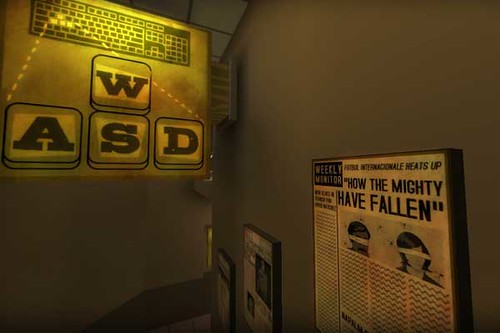
The blog of Daniel McKleinfeld, covering games, movies, and whatever else I wanna talk about.
Wednesday, January 23, 2013
Thomas Was Alone

Sunday, January 20, 2013
Thirty Flights of Loving

I wouldn't want every game– or even most games– to be like Thirty Flights of Loving. But I'm really glad that Thirty Flights of Loving is.
Brendon Chung is sort of the Marcel Duchamp of video games; he's less about providing the pleasures in which his chosen medium specializes and more about creating artifacts that force the viewer to question the medium's definition. Like Duchamp (and unlike most of his imitators), Chung's art is saved from sterility by his seemingly instinctive aesthetic talent.
TFoL is pretty willingly an interactive short story rather than a game. You run from place to place absorbing narrative information, with nothing to really test your ability. Even in the one area where you get to shoot stuff, it quickly becomes obvious that the bang-bang is just there to propitiate gamer reflexes, with no real impact on how the story progresses.
So it's exactly the kind of thing that inspires Steam reviewers to grumble about "hipsters". Previous interactive narrative experiments, like Dear Esther and The Path, were frustrating even to my artfaggy self, as their eschewing of combat or puzzles seemed to be part and parcel of a generally dour dislike of kicks, joy, entertainment value... In short, they seemed to have a sneering contempt for fun, which games should be!
Like those games, TFoL wants to tell you a story rather than challenge you to a battle, but unlike them, Chung understands that a story is fundamentally a machine for creating delight. You'll only be playing it for about 15 minutes, but those 15 minutes are full of color, music, groovy sights, funny jokes, never-seen-that-before techniques, and charmingly irrelevant tangents.
The immersiveness of the experience is cemented by the sturdy reliability of its stories: a heist gone wrong and a love triangle, two templates guaranteed to rope in just about anyone who's ever wanted to be rich or have sex. Because those stories are so familiar, the viewer can't help but try to guess at much of the information that Chung revels in not providing. And if you're the sort of pervert who likes having their brain coochie-coo'ed, coy narrative elision is a potent fan dance.
Trying to figure out what happened in between the game's smash cuts is far more engaging than navigating any of the game's spaces. Which suggests that TFoL is not so much eliminating challenge as shifting where it happens. In most games, getting from one end of the level to the other is difficult while following the story is (insultingly) easy, and in TFoL it's just the opposite. Games are defined by their most challenging aspect, so while most video games are about figuring out fighting patterns with some story as background, TFoL is really a game about figuring out the shape of a tale with some running around corridors as background.
In this brave new era of theory-informed, progressive game design, even a number of big-budget titles have experimented with allusive storytelling. Though Bioshock conveyed plenty of narrative through bog-standard voice-overs, many of the most interesting subplots, like Fontaine's bible-smuggling operation, were suggested by environmental details and other small aspects of the game. The faint whispers of story were the most interesting thing about Dark Souls, imbuing its battles with faint suggestions of tragedy like a utopian monument fallen into ruins.
But in every case, the suggestive storytelling never quite becomes gameplay, because it lacks the pass/fail mechanical demands that more or less define what's important to a player. What's needed now is a game where figuring out the story has in-game consequences, making the act of figuring out a story inherent to the game. Perhaps a role-playing game where you interact with NPC's differently based on conclusions you've made about their background, with consequences for different guesses? Of course, such a mechanic means a developer has to commit to a right interpretation of story hints, which risks undoing exactly what's so interesting about these subtle fragments. Is there a way to make the act of figuring out a story as open, compelling, and challenging as running through a combat zone?